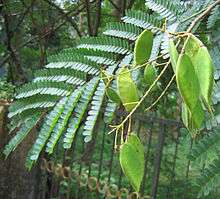Caesalpinia sappan
| Caesalpinia sappan | |
|---|---|
 | |
| Leaves and fruits | |
| Scientific classification | |
| Kingdom: | Plantae |
| (unranked): | Angiosperms |
| (unranked): | Eudicots |
| (unranked): | Rosids |
| Order: | Fabales |
| Family: | Fabaceae |
| Genus: | Caesalpinia |
| Species: | C. sappan |
| Binomial name | |
| Caesalpinia sappan L. | |
Caesalpinia sappan is a species of flowering tree in the legume family, Fabaceae, that is native to Southeast Asia. Common names in English include sappanwood and Indian redwood.[2] Sappanwood belongs to the same genus as Brazilwood (C. echinata), and was originally called "brezel wood" in Europe.
Disease : Twig dieback (Lasiodiplodia theobromae)[3]
This plant has many uses. It possesses medicinal abilities as an antibacterial and for its anticoagulant properties. It also produces a valued type of reddish dye called brazilin, used for dyeing fabric as well as making red paints and inks. Slivers of heartwood are used for making herbal drinking water in various regions, such as Kerala, and Central Java, where it's usually mixed with Ginger, Cinnamon and Clove. Heartwood also contains juglone (5-hydroxy-1,4-naphthoquinone), also an active antimicrobial principle.[4] Homoisoflavonoids (sappanol, episappanol, 3'-deoxysappanol, 3'-O-methylsappanol, 3'-O-methylepisappanol[5] and sappanone A[6]) can also be found in C. sappan.
The wood is somewhat lighter in color than Brazilwood and its other allies, but the same tinctorial principle appears to be common to all. Sappanwood was a major trade good during the 17th century, when it was exported from Southeast Asian nations (especially Siam) aboard red seal ships to Japan.

References
- ↑ World Conservation Monitoring Centre (1998). "Caesalpinia sappan". IUCN Red List of Threatened Species. Version 2009.2. International Union for Conservation of Nature. Retrieved February 11, 2010.
- ↑ "Caesalpinia sappan L.". Germplasm Resources Information Network (GRIN). Retrieved Jul 6, 2016.
- ↑ "CAB Direct".
- ↑ Lim, M.-Y.; Jeon, J.-H.; Jeong, E. Y.; Lee, C. H.; Lee, H.-S. (2007). "Antimicrobial Activity of 5-Hydroxy-1,4-Naphthoquinone Isolated from Caesalpinia sappan toward Intestinal Bacteria". Food Chemistry. 100 (3): 1254–1258. doi:10.1016/j.foodchem.2005.12.009.
- ↑ Namikoshi, Michio; Nakata, Hiroyuki; Yamada, Hiroyuki; Nagai, Minako; Saitoh, Tamotsu (1987). "Homoisoflavonoids and related compounds. II. Isolation and absolute configurations of 3,4-dihydroxylated homoisoflavans and brazilins from Caesalpinia sappan L". Chemical & Pharmaceutical Bulletin. 35 (7): 2761. doi:10.1248/cpb.35.2761.
- ↑ Chang, T. S.; Chao, S. Y.; Ding, H. Y. (2012). "Melanogenesis Inhibition by Homoisoflavavone Sappanone a from Caesalpinia sappan". International Journal of Molecular Sciences. 13 (8): 10359–10367. doi:10.3390/ijms130810359. PMC 3431864
 . PMID 22949866.
. PMID 22949866.
![]() This article incorporates text from a publication now in the public domain: Chisholm, Hugh, ed. (1911). "article name needed". Encyclopædia Britannica (11th ed.). Cambridge University Press.
This article incorporates text from a publication now in the public domain: Chisholm, Hugh, ed. (1911). "article name needed". Encyclopædia Britannica (11th ed.). Cambridge University Press.
External links
![]() Media related to Caesalpinia sappan at Wikimedia Commons
Media related to Caesalpinia sappan at Wikimedia Commons
![]() Data related to Caesalpinia sappan at Wikispecies
Data related to Caesalpinia sappan at Wikispecies
